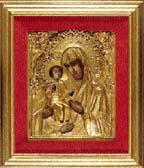
Our Lady of the Three Hands, 19th c. Russian, Slavonic School. Tempera, gesso on wood.
The first art exhibit of the year is set to open at the Wriston Art Gallery. The exhibit is an eclectic combination featuring selections from the university’s permanent collection, modern photography, and centuries-old iconography. Curator Frank Lewis describes the assortment as “a three-part show in three collections.” Modern artworks from Lawrence’s private art stash will be on display in the first gallery, but with a special twist. For the segment of the exhibit titled “Selections of 20th Century Art from the Permanent Collection,” curator Frank Lewis explains, “There’s something that ties the pieces together other than an arbitrary selection of 20th century art.”
The works themselves represent a broad range of 20th century artistic talent. They include the work of an important local artist, a sketch by an associate of Picasso and Braque, and a very recent gallery acquisition by Louise Nevelson titled “The Night Sound” (1971).
The middle gallery consists of an arranged selection of black and white photos, titled “The War Years,” by photographer Lewis Koch. A Wisconsin-based artist for the past 25 years, Koch began his career doing a mixture of documentary work combined with what he describes as “grassroots history, local cultures, and ethnic music traditions.”
His title “The War Years” refers to the effects that the numerous wars the United States has taken part in for the past half-century have had on his outlook and his life.
Koch says of the show, “It’s about one’s life within the belly of the beast.” He added that it’s also about “[how] we as individuals are connected to everything else in the world. We have to recognize that connection, honor that connection, and make something good of it and seek peaceful resolutions as opposed to the global violence that is so prevalent in our society.” Koch also stated that the purpose of his photographs and the exhibition were “not to tell people what to think, but to tell them what I think.”
The last segment of the exhibition will be dedicated to a series of Russian and Greek icons, titled “Russian and Greek Icons from Wisconsin Collections.” In terms of art history, icons are standardized depictions of religious scenes intended for devotional and spiritual purposes. The images and designs on some of the works date from the early sixth century.
Lewis elaborates, “Icons are narratives of the church and are carved from a single block of wood. You have to recess the image, coat it with layers of linen and gesso, then transfer the design.”
To familiarize students with the creative process, a display unit showing the steps involved in making an icon, including real gold leaf and egg tempera, is part of the exhibit.
Many of the icons are encrusted with a thick casing of elaborately wrought gold and silver. Lewis says, “[G]old and silver keep the icon from being just a picture and makes it an object. Generally, icons weren’t prized for their aesthetic properties. Instead, they were prized for their mystical and spiritual power.
“Iconography was a highly developed skill set and a highly developed ritualized craft, and making icons was viewed as a kind of devotion.”
Many of the pieces are on loan from the Payne Art Gallery at the University of Wisconsin-Oshkosh, the University of Wisconsin-Milwaukee, and the Milwaukee Public Museum.
The first art exhibit of the school year opens on Friday, Oct. 3 at 6:00 p.m., with a reception to follow.
